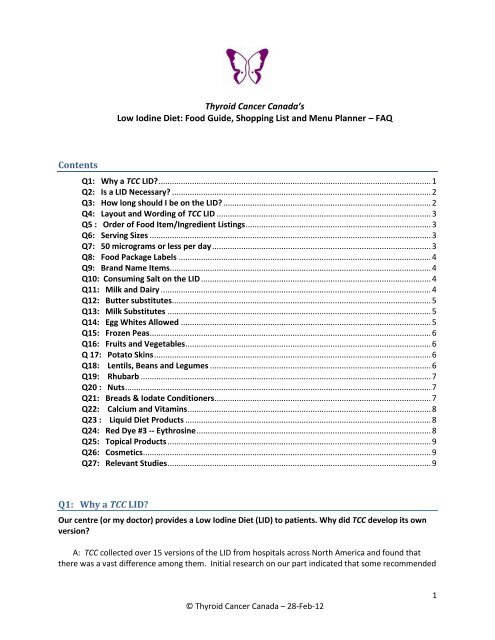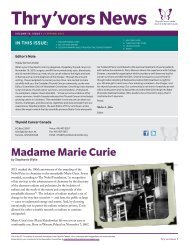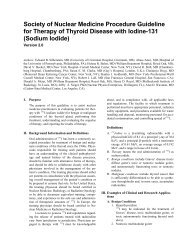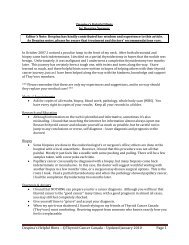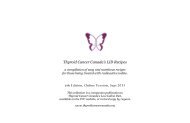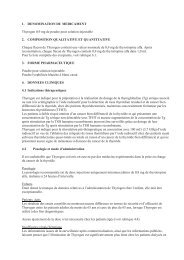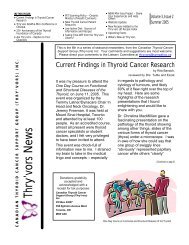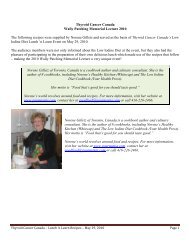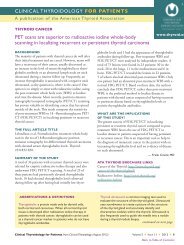Why a TCC LID? - Thyroid Cancer Canada
Why a TCC LID? - Thyroid Cancer Canada
Why a TCC LID? - Thyroid Cancer Canada
Create successful ePaper yourself
Turn your PDF publications into a flip-book with our unique Google optimized e-Paper software.
foods were in fact high sources of iodine (such as dairy products and eggs) and other foods wererestricted for no apparent reason.In 2006, with the help of over 30 experts in the fields of medicine, nutrition, government and thepackaging industry, we developed a definitive and reliable Low Iodine Diet.In 2009, we revised and improved the resource. We have now consulted with over 80 experts,including those in the food industry, associations, government, etc. A list of the <strong>TCC</strong> reviewers isavailable as a separate document entitled “<strong>TCC</strong> Low Iodine Diet 2009, References, Writers & Reviewers”available at www.thyroidcancercanada.org.Q2: Is a <strong>LID</strong> Necessary?My doctor said it’s not necessary to go on the <strong>LID</strong> and/or my doctor did not mention the <strong>LID</strong> tome. Is the diet necessary for a successful radioactive iodine treatment (RAI)?A: Studies since the mid-1960’s that have investigated use of the <strong>LID</strong> in preparation for RAIgenerally conclude that using the <strong>LID</strong> for two weeks prior to RAI will improve the efficacy of thetreatment.In 2010, Sawka et al examined and reported on more than 75 studies on the topic of the <strong>LID</strong>. Theauthors report that the overall evidence indicates that a <strong>LID</strong> does reduce urinary iodine output and thattwo weeks on the diet is about twice as effective as one week. Albeit small studies, at least tworesearch teams, convincingly found that a <strong>LID</strong> increases uptake of I-131 and ablation of remnant tissueor tumours. Although Sawka et al state “unfortunately, there are still no studies examining long-termrecurrence or mortality rates in patients treated with an <strong>LID</strong> compared to an unrestricted diet”, they doconclude that there is compelling evidence that a <strong>LID</strong> should be utilized to aid a successful preparationfor RAI treatment and scanning.Hinds et al (2008) concludes that “An <strong>LID</strong> is an integral element in the management of differentiatedthyroid cancer. Proper guidance and emphasis on the implementation of the diet needs to be providedto patients. Non-compliance may lead to false negative imaging results, misleading the medicalprofessionals and patient. Potentially inadequate management of the patient’s thyroid cancer mayfollow.”References:Hinds, S.R., Stack, A.L and Stocker, D.J., (2008), “Low-iodine Diet Revisited. Importance in Nuclear Medicine Imaging and Management.Clinical Nuclear Medicine, 33(4), p. 247 – 250.Sawka AM, Ibrahim-Zada I, Galacgac P, Tsang RW, Brierley JD, Ezzat S, and Goldstein DP, Dietary Iodine Restriction in Preparation forRadioactive Iodine Treatment or Scanning in Well-Differentiated <strong>Thyroid</strong> <strong>Cancer</strong>: A Systematic Review, THYROID, 2010 October; 20(10): 1129–1138Q3: How long should I be on the <strong>LID</strong>?A. <strong>TCC</strong>’s research indicated that 2 weeks before ingesting the RAI dose, and 1-2 days after ingestingit, is an adequate length of time for patients undergoing RAI treatment or scans in order for an effectiveresult of the diet.References: as above, andwww.thyroidcancerdoctor, Entry: Urinary Iodide Testing - <strong>Thyroid</strong><strong>Cancer</strong>Help, August, 2007 and How long on <strong>LID</strong> post RAI? -<strong>Thyroid</strong><strong>Cancer</strong>Help, June, 2007© <strong>Thyroid</strong> <strong>Cancer</strong> <strong>Canada</strong> – 28-Feb-122
Q4: Layout and Wording of <strong>TCC</strong> <strong>LID</strong><strong>Why</strong> is the <strong>TCC</strong> <strong>LID</strong>: Food Guide, Shopping List and Menu Planner written the way it is (ie. usingplain language and colour-coded)?A: There is important and relevant Canadian data indicating that in regard to literacy (and especiallyhealth literacy) techniques of clear language and design are very important. There is considerableevidence-based research supporting the use of a patient and family-centred approach to developinghealth information.The use of red and green backgrounds to emphasize restricted and allowed foods, respectively, wassupported by the conventional use of that colour scheme. The design and layout choices werepainstakingly researched and, to that end, <strong>TCC</strong> recommends that healthcare providers not photocopythe <strong>TCC</strong> <strong>LID</strong>. Full-colour, professionally printed copies are easily available by contacting <strong>TCC</strong> directly.Reference:Wizowski, L., Harper, T. and Hutchings, T. (2008). Writing health information for patients and families. 3 rd edition. Hamilton, ON: HamiltonHealth Sciences. For information or to order: PatientEducation@hhsc.caQ5 : Order of Food Item/Ingredient Listings<strong>Why</strong> are the AVOID foods listed in the first column and the ALLOWED foods in the second column,in the <strong>TCC</strong> <strong>LID</strong> Food Guide?A: Expert opinion advised us that patients (who may have difficulty following the directionsespecially if they are hypothyroid) are better off knowing first what they cannot consume. To furtheremphasize this point, the AVOID ingredients are listed in a column shaded with a red background.Q6: Serving Sizes<strong>Why</strong> does the <strong>TCC</strong> <strong>LID</strong> Food Guide specify serving sizes for some foods?A: A <strong>LID</strong> is a LOW iodine diet, not a NO iodine diet. It is virtually impossible to eliminate iodinecompletely from one’s diet. Thus one must adhere to <strong>TCC</strong> <strong>LID</strong> in order to make the best effort to stayunder the 50mcg/day (or less) level, considered the standard by experts. In order to balance nutrientsand give patients as many choices as possible, foods with low amounts of iodine are allowed as long asmoderate servings are consumed. This includes meats and grain products, which have restricted servingsizes on <strong>TCC</strong> <strong>LID</strong>. Wherever possible, serving sizes are in accordance with the <strong>Canada</strong> Food Guide.Reference:http://www.hc-sc.gc.ca/fn-an/food-guide-aliment/index-eng.phpQ7: 50 micrograms or less per day<strong>Why</strong> does the <strong>TCC</strong> <strong>LID</strong> specify a 50mcg per day limit on iodine?A: Although more research into the effects of the <strong>LID</strong> on RAI treatment as well as <strong>LID</strong> limitations isneeded, most of that which does exist specifies a standard of 50mcg or less/day.References:Ain, KB, 2005. “Introduction: What is the Low Iodine Diet and <strong>Why</strong> do you Need it?” in Gilletz, N. The Low Iodine Cookbook. Your HealthPress, Toronto.© <strong>Thyroid</strong> <strong>Cancer</strong> <strong>Canada</strong> – 28-Feb-123
Q8: Food Package LabelsWhich part of a food package label should a patient be sure to read?A: In <strong>Canada</strong>, food packages contain both a Nutrition Facts chart and an Ingredients list. Patientsmay find it confusing to view the Nutrition Facts chart as, for example, “sodium” content may be listed.Since the source of the sodium may not be salt, this information is not normally relevant.<strong>TCC</strong> recommends that patients on the <strong>LID</strong> pay special attention to the Ingredients list, as it lists (inparagraph form) the ingredients in the package in descending order (by largest to smallest in content).The Ingredients list provides vital information in regard to restricted items, such as: salt, dairy, soy andeggs.Q9: Brand Name Items<strong>Why</strong> does the <strong>TCC</strong> <strong>LID</strong> Shopping List specify brand names?A: To aid patient-shoppers when they are faced with an overwhelming number of products tochoose from, we have specified some products by brand name for their convenience. However, we havelimited the number of products identified in <strong>TCC</strong> <strong>LID</strong> Shopping List, as we are mindful that there can bevariations in the ingredients and manufacturing processes for otherwise identical products, dependingon the manufacturing location (ie. from one region of <strong>Canada</strong> to another). As well, package ingredientsmay change over time. We strongly recommend that all packages be checked for content prior topurchase, and provide this reminder in several locations on the pamphlet.Q10: Consuming Salt on the <strong>LID</strong>Should salt be allowed on the <strong>LID</strong>? Is it possible to purchase iodine-free salt in <strong>Canada</strong>?A: All table salt sold in <strong>Canada</strong> has been iodized by federal regulation. In the USA, both iodized andnon-iodized table salt is available. Windsor Salt Company assures us that they do not add iodine to theircoarse salts nor Kosher salts. However, the same may not be true of other manufacturers of coarsesalts. As well, sea salt of any type is restricted on the <strong>LID</strong> as all products from the sea have varying levelsof iodine, often beyond that allowed on a low iodine diet.As Canadian packaging regulations do not require manufacturers to specify the origin or type of saltused in their products, all packaged goods and all food items listing salt as an ingredient are restrictedon <strong>TCC</strong> <strong>LID</strong>.Because all of the above information regarding salt has the potential of being confusing to patients,every attempt is made to be specific in <strong>TCC</strong> <strong>LID</strong> materials.Q11: Milk and DairyPatients often miss being able to have a little milk in their coffee. Can one allow a smallconsumption of milk/dairy daily?© <strong>Thyroid</strong> <strong>Cancer</strong> <strong>Canada</strong> – 28-Feb-124
A: Although there are varying degrees of iodine in milk products, it is potentially a very high source.According to data collected by Jean Pennington (Pennington, J; Douglass J, Bowes & Churches FoodValues of Portions Commonly Used), 8 fl oz of milk on average has almost 50mcg of iodine (ie. all theiodine allowed in one day on the <strong>LID</strong>). The same is true for other dairy products, which generally arehigh in iodine (Pearce et al, 2004; Pennington & Douglass, 2005; USFDA, 2006) and are not permitted on<strong>TCC</strong> Low Iodine Diet. The actual levels of iodine in milk can vary regionally, seasonally and per processingmethod (Hemling, 2001). The <strong>TCC</strong> <strong>LID</strong> does provide information for milk substitutes such as rice, hempand nut milks (see Q13 below).Reference:http://www.milkproduction.com/Articles1/articleFramedMain.asp?NSI0164Q12: Butter substitutesCan a person on the <strong>LID</strong> eat margarine?A: Currently in <strong>Canada</strong>, we don't know of any brand of margarine that is <strong>LID</strong>-compatible (previouslyto December 2010, Fleischmann’s Salt Free, Lactose Free Margarine was a <strong>LID</strong>-allowed product, butUnilever has now discontinued this product).It may be possible to find a margarine product in the USA that meets all the criteria of the <strong>LID</strong> -- thatis; is milk/dairy, salt and soybean free. Alternatively in recipes calling for margarine, one can substitutevegetable oil on a 1:1 ratio.References:Unilever <strong>Canada</strong> (416) 964-1857Norene Gilletz, author of The Low Iodine Diet Cookbook, Your Health Press, Toronto. (personal conversation, March 2011)Q13: Milk Substitutes<strong>Why</strong> does the <strong>TCC</strong> <strong>LID</strong> specify YÜ RICE BEVERAGE and LIVING HARVEST HEMP MILK?A: Our research indicated that only the YÜ brand of rice milk is salt-free. The same applies to theLiving Harvest brand of hemp milk. Patients can also prepare homemade rice milk, hemp milk and nutmilk. The recipes are available online at www.thyroidcancercanada.orgQ14: Egg Whites Allowed<strong>Why</strong> does <strong>TCC</strong> <strong>LID</strong> allow egg whites but not egg yolks?A: Most of the iodine in eggs is concentrated in the yolk. Although egg yolk is about 1/3 of the eggby weight, it contains 96% of the iodine.According to Kaufmann (1997) hen eggs contain on average 1,135 ± 205 μg iodine per kg of yolk and 49 ±14 μg iodine per kg of albumen (egg white). That is, one egg on average has 20mcg of iodine in the yolk and1.5 mcg in the white.References:Veterinarni Medicina, 51, 2006 (3): 93–100 Iodine content in consumer hen eggs J. Travnicek, V. Kroupova, I. Herzig, J. Kursahttp://www.joyofbaking.com/eggs.html© <strong>Thyroid</strong> <strong>Cancer</strong> <strong>Canada</strong> – 28-Feb-125
Q15: Frozen Peas<strong>Why</strong> does <strong>TCC</strong> <strong>LID</strong> specify avoiding frozen peas?A: A food quality expert at McCains Foods (<strong>Canada</strong>) advised us that unlike other frozen vegetablesthat may be salt-free, peas are routinely washed in a salt-solution (brine) prior to freezing. The amountof salt is small enough that government food regulations do not require them to list salt in theingredient list on the package. However, the sodium content listed in the Nutrition Facts on a package offrozen peas (for the most part) refers to residue salt content. Since we cannot be sure what quantityand which type of salt was used, we have included frozen peas in the AVOID list on <strong>TCC</strong> <strong>LID</strong>.Reference:http://www.mccain.com/Q16: Fruits and VegetablesThe <strong>TCC</strong> <strong>LID</strong> does not restrict most vegetables and fruits, nor does it address variation in levels ofiodine in soils across various regions. <strong>Why</strong> is that?A: While there is some iodine in fruits and vegetables, and soils can vary in regards to their iodinecontent, the amounts measured in these food items is relatively low regardless of the source or type.Reference:http://www.foodcomp.dk/fcdb_foodcomplist.asp?CompId=0066Souci, Fachmann & Kraut, Food composition & nutrition tables 6th ed.2000Composition of Core Foods of the US Food Supply, 1982-1991" By Pennington, Schoen et al.The Composition of Foods, McCance & Widdowson, 6th ed 2002Q 17: Potato SkinsAre potato skins a high source of iodine?A: Several versions of the <strong>LID</strong> restrict the consumption of potato skins (presumably due to iodinelevels in soils). However, there is no known plant physiology indicating that plants are able to selectivelyconcentrate iodine, so there is no reason for the peel to be any higher than the rest of the vegetable.<strong>TCC</strong> research indicates that restrictions against potato skins are not necessary. Our data suggests that asingle average-sized potato including its skin contains less that 1mcg of iodine.References:As aboveQ18: Lentils, Beans and LegumesSome <strong>LID</strong>s suggest that lentils, beans and legumes are all high in iodine. Is that true?A: Lentils, beans and legumes have been tested at less that 1mcg per serving on average in the dataquoted above.References:As above© <strong>Thyroid</strong> <strong>Cancer</strong> <strong>Canada</strong> – 28-Feb-126
Q19: RhubarbSome <strong>LID</strong>s specify that rhubarb has relatively high iodine content. Is that true?A: Reliable food content listings indicate that rhubarb is no more iodine-laden than any othercommon fruit or vegetable, that is, it is a relatively low source of iodine.Reference:http://www.foodcomp.dk/fcdb_foodcomplist.asp?CompId=0066Q20 : NutsShould there be restrictions on the amount of nuts consumed daily while on the <strong>LID</strong>?A: Nuts are generally a moderately low source of iodine, rather than a very low source of iodine. Theyshould be consumed in portion sizes as per the <strong>Canada</strong> Food Guide, (ie. as a meat alternative, one servingwould be 1/4 cup nuts, or 2 tbsp). That is, they should not be consumed in unlimited quantities. It is for thisreason that nuts are listed as a meat-alternative item (e.g. for vegetarians) but not listed as a snack item in<strong>TCC</strong> <strong>LID</strong>.Reference:http://www.hc-sc.gc.ca/fn-an/food-guide-aliment/choose-choix/meat-viande/serving-portion-eng.phpQ21: Breads & Iodate ConditionersAre iodate conditioners added to breads as a preservative? Are these a high source of iodine?A: Yes, iodate bread conditioners are potentially a source of dietary iodine and are to be avoided.We have been advised that Canadian source flour rarely has iodate added, but this may not be so if thebread or its flour originates from outside the country."... to the very best of my knowledge no Iodate compounds are used in the mainstream Baking industry in<strong>Canada</strong> anymore. Though Potassium Iodate is a permitted additive it is not used... "*"To the best of my knowledge based on replies from our members, no wheat or oat milling firms areadding any iodine-containing food additive to milled wheat or oat products." **"I have been made aware by one of our industry's ingredient supplier that they do sell aconditioning blend that contains a small amount potassium iodate... the conditioner in questionis most commonly used mostly in hotdog/hamburger rolls.... this would then translate toapproximately 1.2ppm (mcg) of iodine present in a 50g roll."***The main concern in regards to breads is not the possible iodate conditioners, but rather other highsources of iodine such as: milk, whole eggs, and iodized salt. <strong>TCC</strong> has found that 2 brands of breads areavailable that meet all requirements of the <strong>LID</strong>, as follows:Nature's Path Manna Bread (available in the frozen food section of Loblaws/Fortinos/SuperStoressupermarkets)Dimpflmeier Salt-Free Rye Bread (available at the deli counter of Metro supermarkets)References:* email correspondence, February 1, 2012, Tony Tweed, Head, Baking Technology, Canadian International Grains Institute www.cigi.ca** email correspondence, February 6, 2012, Gordon Harrison, Canadian National Millers Association (CNMA)*** email correspondences, February 3, 9 & 27, 2012, Paul Hetherington, Baking Association of <strong>Canada</strong> (BAC)© <strong>Thyroid</strong> <strong>Cancer</strong> <strong>Canada</strong> – 28-Feb-127
Q22: Calcium and VitaminsIs it safe to take Calcium supplements while on the <strong>LID</strong>? What about vitamins?A: Although iodine may not have been added to some calcium products, one must also be awarethat if the origin of the product was sea-based (such as oyster shell based), such products may be high innatural iodine. Iodine-free calcium is available and patients can consult with their pharmacist to insurethat the products they take are free of both added and natural iodine (in the form of sea basedingredients).Patients on the <strong>LID</strong> can also be reminded that green leafy vegetables and raw almonds are a goodsource of calcium, and allowable on the diet.Vitamins are also often a high source of added iodine, and best avoided altogether while on the <strong>LID</strong>.However, any patient who takes doctor-prescribed doses of minerals and/or vitamins should discussthis issue with their doctor prior to the <strong>LID</strong>. This is especially true for those taking calcium due tohypoparathyroidism.Q23 : Liquid Diet ProductsCan patients on a liquid diet, ie. such as BOOST, ENSURE, RESOURCE 2.0, CARNATION shakes,puddings etc. continue using these as substitutes for meals?A: No, these liquid meal substitutes are not <strong>LID</strong>-compatible. Patients, who have a medicalrequirement for liquid meal substitutes, should discuss their medical condition with their doctor prior toundergoing the <strong>LID</strong>.Q24: Red Dye #3 -- EythrosineWhat are the problems surrounding the consumption and labelling of Red Dye #3 in foodproducts?A: Red Dye #3 (eythrosine) is made up primarily of iodine and is thereby a high source; restricted on<strong>TCC</strong> <strong>LID</strong>. Although it is a dye not commonly used in food products in <strong>Canada</strong>, patients on the <strong>LID</strong> mustbe diligent in avoiding it. It is primarily used to colour red soda pop (cream soda), maraschino cherries,and some red medications. Red dyes are also used as a colouring in some red-coloured breakfastcereals. In <strong>Canada</strong>, the packaging regulations do not require manufacturers to specify Red Dye #3 (or tospecify any food colourings other than Annatto) on packages. Instead, if dye of any type has been addedto a food, they need only specify the word “colour” on the ingredient list. Therefore we advise patientson the <strong>LID</strong> to avoid any foods that list the word “colour” on the label and are red in colour. Thisincludes: the foods named above as well as red fruit punch drinks and powdered drinks. As well,patients should check with their pharmacists to be sure Red Dye #3 was not used in their medicationSpecifically, the Canadian regulations state "one or more of the colours listed in Table III of Division16, except annatto where used in accordance with paragraph B.14.031(i) or subparagraphB.14.032(d)(xvi)" can be declared as "colour".© <strong>Thyroid</strong> <strong>Cancer</strong> <strong>Canada</strong> – 28-Feb-128
Q25: Topical ProductsShould one be concerned with topical products made with iodine?A: Betadine is an antiseptic that has iodine as its active ingredient. It is mainly used in hospitalsettings as a surgical scrub (75% iodine solution is used). However, there is also a version (BETADINE®Solution) meant for home use which is 10% iodine. This product is to be avoided while on the <strong>LID</strong>. Aswell, iodine may be used in some pre-moistened disposable products, such as baby wipes and femininewipes.Reference:http://www.pharma.com/PI/NonPrescription/A6910BE3.pdfQ26: CosmeticsShould one be concerned about the use of Red Dye #3 in cosmetics, especially red lipstick?A: The use of Red Dye #3 is not permitted in <strong>Canada</strong> in any cosmetic products.Reference:Paul Breha, R&D Chemist, The Bonne Bell Company, email: Sept 24/08Q27: Relevant StudiesWhat studies are available to reinforce the need for the <strong>LID</strong>?A: In addition to studies referenced above, we suggest the following studies:Sawka AM, Ibrahim-Zada I, Galacgac P, Tsang RW, Brierley JD, Ezzat S, and Goldstein DP, Dietary IodineRestriction in Preparation for Radioactive Iodine Treatment or Scanning in Well-Differentiated <strong>Thyroid</strong><strong>Cancer</strong>: A Systematic Review, THYROID, 2010 October; 20(10): 1129–1138Two-Week Low Iodine Diet Is Necessary for Adequate Outpatient Preparation for Radioiodine rhTSHScanning in Patients Taking Levothyroxine, Joel T. Park II and James V. Hennessey THYROID Volume 14,Number 1, 2004Effects of low-iodide diet on postsurgical radioiodide ablation therapy in patients with differentiatedthyroid carcinoma Maurice J. H. M. Pluijmen, Carmen Eustatia-Rutten, Bernard M. Goslings, Marcel P.Stokkel, Alberto M. Pereira Arias, Michaela Diamant, Johannes A. Romijn and Jan W. A. Smit, ClinicalEndocrinology (2003) 58, 428–435Reevaluation of Stringent Low Iodine Diet in Outpatient Preparation for Radioiodine Examination andTherapy, TOMODA CHISATO, URUNO TAKASHI, TAKAMURA YUUKI, ITO YASUHIRO, MIYAAKIHIRO, KOBAYASHI KAORU, MATSUZUKA FUMIO, AMINO NOBUYUKI, KUMA KANJI, MIYAUCHIAKIRA, Endocrine Journal 2005 VOL.52;NO.2;PAGE.237-240Low-iodine diet revisited: importance in nuclear medicine imaging and management, Hinds SR 2nd,Stack AL, Stocker DJ., Clinical Nuclear Medicine 2008 Apr;33(4):247-50© <strong>Thyroid</strong> <strong>Cancer</strong> <strong>Canada</strong> – 28-Feb-129


